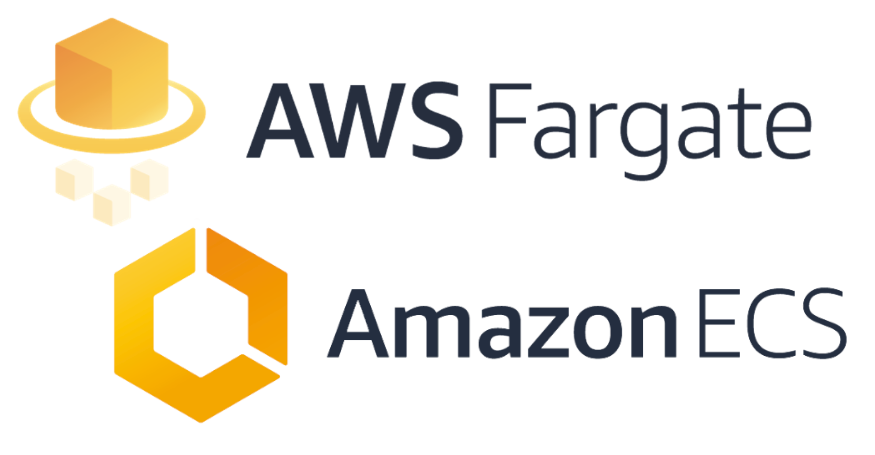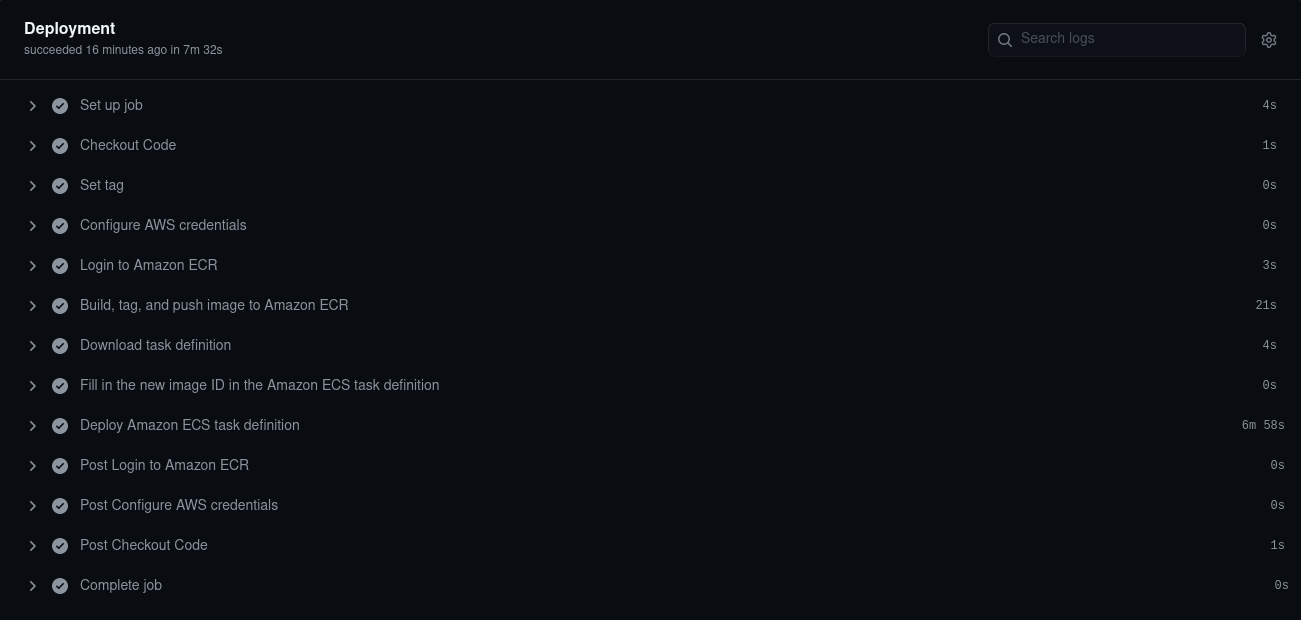
CI/CD using Github Actions, AWS ECR and ECS Fargate
AWS Fargate is a CaaS (Container as a Service) solution allowing to deploy containers on Amazon ECS and Amazon EKS without provisionning EC2 instances. The goal is to only reserve the resources required for a container, thus reducing the maintenance cost and the engineering needed to deploy applications.
AWS provides Github Actions to allow integrating Continuous Integration and Continuous Delivery to AWS solutions.
In this article, we will setup the main components of a serverless infrastructure on AWS using Terraform, a set of jobs on Github Actions and an example application to try out this configuration.
note: we talked about building container images in the past, this article focuses on AWS integrations !
Creating an ECS infrastructure on AWS
In order to deploy ECS tasks, we have the following requirements to expose our containers:
- An Application Load Balancer which will serve as a public entrypoint
- An ECS Cluster to deploy our service
- An ECS Service to run our ECS Tasks
- An Elastic Container Registry (ECR) to store our container images
We will setup the AWS infrastructure using the AWS Terraform Provider.
We won’t cover the VPC configuration and will rely on an existing VPC, referenced
by its id in local.vpc["id"].
data "aws_vpc" "main" {
id = local.vpc["id"] # vpc-xx1x1x1x
}
data "aws_subnet" "subnets" {
# availability_zones = ["eu-west-3a", "eu-west-3b", "eu-west-3c"]
for_each = toset(local.vpc.availability_zones)
vpc_id = data.aws_vpc.main.id
availability_zone = each.value
}
Using the VPC-related datasources, we gathered the subnets which will be used for our Application Load Balancer.
For the sake of this example, we’ll use the ALB as our web entrypoint,
switching its internal attribute to false to expose it.
resource "aws_lb" "alb" {
name = local.lb["name"] # tf-alb
internal = local.lb["internal"] # false
load_balancer_type = "application"
subnets = [for s in data.aws_subnet.subnets : s.id]
}
In addition, we’ll define a Load Balancer Target Group as well as a Load Balancer Listener to route traffic to our target group.
resource "aws_lb_target_group" "group" {
name = local.lb.target_group["name"]
port = local.lb.target_group["port"]
protocol = local.lb.target_group["protocol"]
vpc_id = data.aws_vpc.main.id
target_type = "ip"
depends_on = [aws_lb.alb]
}
resource "aws_lb_listener" "front_end" {
load_balancer_arn = aws_lb.alb.arn
port = "80"
protocol = "HTTP"
default_action {
type = "forward"
target_group_arn = aws_lb_target_group.group.arn
}
}
We can now setup our Application Load Balancer using Terraform:
$ terraform apply -auto-approve
...
Apply complete! Resources: 3 added, 0 changed, 0 destroyed.
Outputs:
app_url = "tf-alb-1725491528.eu-west-3.elb.amazonaws.com"
$ curl -I tf-alb-1725491528.eu-west-3.elb.amazonaws.com
HTTP/1.1 503 Service Temporarily Unavailable
Server: awselb/2.0
Our ALB is fully functioning ! It is now time to create some ECS tasks. We will start by creating the cluster, defining a ECS Service and a basic task to try out the configuration.
In order to leverage the capabilities of Fargate, we simply have
to define FARGATE as the only capacity provider for our cluster.
resource "aws_ecs_cluster" "cluster" {
name = local.ecs["cluster_name"] # "ecs-cluster"
capacity_providers = ["FARGATE"]
default_capacity_provider_strategy {
capacity_provider = "FARGATE"
weight = "100"
}
}
Using this ECS Cluster, we can now define our task and the corresponding ECS service. In order to run tasks on ECS, we need to provide an execution role (see Task execution IAM role for more details).
We will not cover the IAM permissions in this article but the complete repository is available in this repository.
resource "aws_ecs_task_definition" "task" {
family = "service"
requires_compatibilities = [
"FARGATE",
]
execution_role_arn = aws_iam_role.fargate.arn
network_mode = "awsvpc"
cpu = 256
memory = 512
container_definitions = jsonencode([
{
name = local.container.name # "application"
image = local.container.image # "particule/helloworld"
essential = true
portMappings = [
{
containerPort = 80
hostPort = 80
}
]
}
])
}
resource "aws_ecs_service" "service" {
name = local.ecs.service_name
cluster = aws_ecs_cluster.cluster.id
task_definition = aws_ecs_task_definition.task.arn
desired_count = 1
network_configuration {
subnets = [for s in data.aws_subnet.subnets : s.id]
assign_public_ip = true
}
load_balancer {
target_group_arn = aws_lb_target_group.group.arn # our target group
container_name = local.container.name # "application"
container_port = 80
}
capacity_provider_strategy {
base = 0
capacity_provider = "FARGATE"
weight = 100
}
}
In the configuration above, we create an ECS Task Definition with 1/4th of a CPU
and 512MB of RAM, the smallest possible specifications. We also specify the container
we want to run, we’ll start with a default “Hello World” application using
particule/helloworld.
The list of resource specifications is available in the ECS - Fargate documentation.
$ terraform apply -auto-approve
...
Apply complete! Resources: 4 added, 0 changed, 0 destroyed.
Outputs:
app_url = "tf-alb-1725491528.eu-west-3.elb.amazonaws.com"
$ curl -I tf-alb-1725491528.eu-west-3.elb.amazonaws.com
HTTP/1.1 200 OK
Server: nginx/1.10.1
X-Powered-By: PHP/5.6.30
We now have the infrastructure to deploy ECS task ! We can now finalize our terraform configuration by creating an ECR to publish our images to, as well as some credentials to implement the CI/CD in Github Actions.
resource "aws_ecr_repository" "repository" {
name = local.ecr["repository_name"] # "repository"
image_tag_mutability = "MUTABLE"
}
We can now create an IAM user which will be used for our CI.
resource "aws_iam_user" "publisher" {
name = "ecr-publisher"
path = "/serviceaccounts/"
}
resource "aws_iam_access_key" "publisher" {
user = aws_iam_user.publisher.name
}
In order to ease the configuration of our Github repository secrets, we define some Terraform outputs:
output "publisher_access_key" {
value = aws_iam_access_key.publisher.id
description = "AWS_ACCESS_KEY to publish to ECR"
}
output "publisher_secret_key" {
value = aws_iam_access_key.publisher.secret
description = "AWS_SECRET_ACCESS_KEY to upload to the ECR"
sensitive = true
}
output "ecr_url" {
value = aws_ecr_repository.repository.repository_url
description = "The ECR repository URL"
}
Let’s apply this last bit of configuration to finalize our setup !
$ terraform apply -auto-approve
...
Apply complete! Resources: 4 added, 0 changed, 0 destroyed.
Outputs:
app_url = "tf-alb-1725491528.eu-west-3.elb.amazonaws.com"
aws_region = "eu-west-3"
container_name = "application"
ecr_repository_name = "app-registry"
ecr_url = "111111111111.dkr.ecr.eu-west-3.amazonaws.com/app-registry"
ecs_cluster = "ecs-cluster"
ecs_service = "ecs-service"
publisher_access_key = "AAAAAAAAAAAAAAAAAAAA"
publisher_secret_key = <sensitive>
Our AWS infrastructure is now complete ! We can follow-up with the configuration of our Github repository.
Configuring our repository’s CI/CD
As stated earlier, AWS maintains some github actions which can be used to automate deployements and to interact with AWS services.
We will configure a Workflow with some mock integration tests and a deployment that will build a Docker image, publish it to our ECR and update the corresponding ECS task.
note: interactions with github will be made using the Github CLI (gh).
Let’s start by creating the base workflow file and defining the mock integration
job. We want our Workflow to run on every commit related to the main branch,
and to deploy it every time a new tag is pushed (and the CI passes !).
---
name: "workflow"
'on':
push:
branches:
- main
tags:
- "*"
pull_request:
branches:
- main
jobs:
integration:
name: "CI"
runs-on: "ubuntu-latest"
steps:
- name: "Checkout Code"
uses: "actions/checkout@v2"
- name: "Lint code"
run: echo "Linting repository"
- name: "Run unit tests"
run: echo "Running unit tests"
As previously mentioned, the integration job’s sole purpose is to create a dependency to experiment with the deployment, which we will define below.

We want the CD to be executed:
- if the ingration tests (unit tests, linting) are passing
- if the trigger event is a tag
cd:
name: "Deployment"
runs-on: "ubuntu-latest"
needs:
- ci
if: startsWith(github.ref, 'refs/tags/')
Using AWS github actions, we will execute the following tasks:
- configure the AWS credentials (configure-aws-credentials)
- log in to our previously created ECR (amazon-ecr-login)
- build and push our Docker image
- edit the ECS task with the new image (ecr-render-task)
- update the ECS service (ecr-deploy-task)
The Deployment job steps are defined below:
- name: Configure AWS credentials
uses: aws-actions/configure-aws-credentials@v1
with:
aws-access-key-id: ${{ secrets.AWS_ACCESS_KEY_ID }}
aws-secret-access-key: ${{ secrets.AWS_SECRET_ACCESS_KEY }}
aws-region: ${{ secrets.AWS_REGION }}
- name: Login to Amazon ECR
id: login-ecr
uses: aws-actions/amazon-ecr-login@v1
- name: Build, tag, and push image to Amazon ECR
id: build-image
env:
ECR_REGISTRY: ${{ steps.login-ecr.outputs.registry }}
ECR_REPOSITORY: ${{ secrets.ECR_REPOSITORY }}
IMAGE_TAG: ${{ steps.vars.outputs.tag }}
run: |
docker build -t $ECR_REGISTRY/$ECR_REPOSITORY:$IMAGE_TAG .
docker push $ECR_REGISTRY/$ECR_REPOSITORY:$IMAGE_TAG
echo "::set-output name=image::$ECR_REGISTRY/$ECR_REPOSITORY:$IMAGE_TAG"
- name: Download task definition
run: |
aws ecs describe-task-definition --task-definition service \
--query taskDefinition > task-definition.json
- name: Fill in the new image ID in the Amazon ECS task definition
id: task-def
uses: aws-actions/amazon-ecs-render-task-definition@v1
with:
task-definition: task-definition.json
container-name: application
image: ${{ steps.build-image.outputs.image }}
- name: Deploy Amazon ECS task definition
uses: aws-actions/amazon-ecs-deploy-task-definition@v1
with:
task-definition: ${{ steps.task-def.outputs.task-definition }}
service: ${{ secrets.ECS_SERVICE }}
cluster: ${{ secrets.ECS_CLUSTER }}
wait-for-service-stability: true
We now have to configure our Github Repository secrets ! Using the outputs we
defined in Terraform, we can easily set them using gh.
$ gh secret set AWS_ACCESS_KEY_ID -b $(terraform output -raw publisher_access_key)
✓ Set secret AWS_ACCESS_KEY_ID for tbobm/tf-ecr-ecs-gh-deploy
$ gh secret set AWS_SECRET_ACCESS_KEY -b $(terraform output -raw publisher_secret_key)
✓ Set secret AWS_SECRET_ACCESS_KEY for tbobm/tf-ecr-ecs-gh-deploy
$ gh secret set AWS_REGION -b $(terraform output -raw aws_region)
✓ Set secret AWS_REGION for tbobm/tf-ecr-ecs-gh-deploy
$ gh secret set ECR_REPOSITORY_NAME -b $(terraform output -raw ecr_repository_name)
✓ Set secret ECR_REPOSITORY_NAME for tbobm/tf-ecr-ecs-gh-deploy
$ gh secret set ECS_CLUSTER -b $(terraform output -raw ecs_cluster)
✓ Set secret ECS_CLUSTER for tbobm/tf-ecr-ecs-gh-deploy
$ gh secret set ECS_SERVICE -b $(terraform output -raw ecs_service)
✓ Set secret ECS_SERVICE for tbobm/tf-ecr-ecs-gh-deploy
$ gh secret list
AWS_ACCESS_KEY_ID Updated 2021-03-30
AWS_REGION Updated 2021-03-30
AWS_SECRET_ACCESS_KEY Updated 2021-03-30
ECS_CLUSTER Updated 2021-03-30
ECR_REPOSITORY_NAME Updated 2021-03-30
ECS_SERVICE Updated 2021-03-30
So far we have:
- Setup our AWS infrastructure
- Created a Github Actions Workflow
- Configured our repository secrets
Let’s try out our configuration with a basic API.
Testing our workflow
Currently, our ECS task is running an Hello World application. We’ll commit and push an example HTTP API to validate our deployment workflow.
$ ls
app.py Dockerfile README.md requirements.txt terraform
$ curl tf-alb-1725491528.eu-west-3.elb.amazonaws.com
<html>
<head>
<!-- ... -->
</head>
<body>
<img id="logo" src="logo.png" />
<h1>Hello world!</h1>
<h3>My hostname is ip-172-31-1-133.eu-west-3.compute.internal</h3>
</body>
$ git add app.py Dockerfile requirements.txt
$ git commit -m 'add example application'
$ git tag 0.0.0
$ git push origin --tags
Total 0 (delta 0), reused 0 (delta 0), pack-reused 0
To github.com:tbobm/tf-ecr-ecs-gh-deploy.git
* [new tag] 0.0.0 -> 0.0.0
This will trigger the complete workflow, starting with the Integration job and proceeding with the Deployment job afterwards, if the CI is successful.

After a couple of minutes, we can try to access our ALB’s public address to ensure the ECS task got properly updated:
curl tf-alb-1725491528.eu-west-3.elb.amazonaws.com
{
"message": "Hello from ip-172-31-13-81.eu-west-3.compute.internal"
}
Our new application successfully got deployed ! We can see that the IP changed as AWS created a new instance of our task behind the scene.
Final note
This configuration is not aimed for production purpose as is but can be a great way to perform unit tests and integration tests on an application !
Some key points that could be implemented to extend this setup:
- Extend the task definition to implement a more realist application (environment variables, volumes, access to other services)
- Logging using AWS CloudWatch (documentation)
- Autoscaling for your ECS Service (documentation)
- Configure Route53 as the public entrypoint (documentation)
The complete repository is available at tbobm/tf-ecr-ecs-gh-deploy.
Theo “Bob” Massard, Cloud Native Engineer
